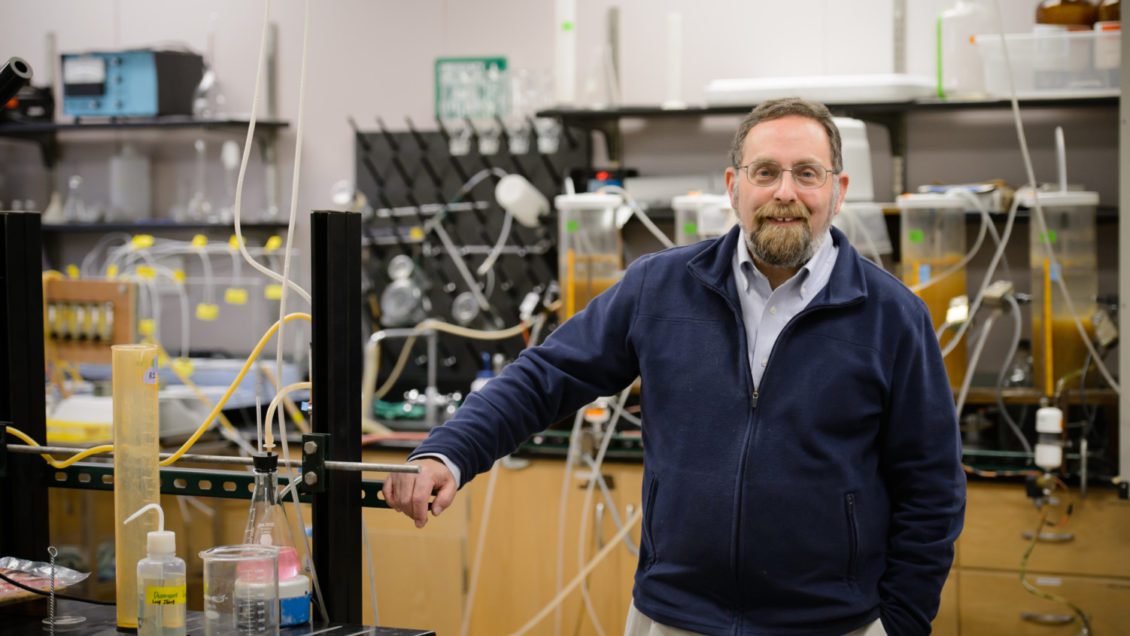David Freedman of Clemson University is testing coronavirus levels in wastewater on the University’s main campus and in the surrounding community to provide an early warning system that shows how fast the virus is spreading.
Freedman likens the tests to the “canary in the coal mine” that can help administrators make informed decisions about what they need to do to protect the public’s health even before COVID-19 case counts start to rise. In addition to campus, his testing covers the city of Clemson and the Town of Pendleton, both home to many of the University’s students, faculty and staff.

Clemson City Council unanimously passed an ordinance on June 24 that mandated face coverings in several circumstances in public after Freedman found surprisingly high virus levels at the city’s Cochran Road wastewater treatment plant.
The ordinance cited “elevated levels of virus in the community similar to levels in other cities in which an outbreak of the virus was about to occur or was well underway.”
Previous studies first done in Europe have shown that the virus starts showing up in wastewater as much as 1-2 weeks before clinical symptoms are reported, said Freedman, who is chair of the University’s Department of Environmental Engineering and Earth Sciences.
“Even before people are coughing and getting a fever, they’ll start shedding the virus in their feces, and that will show up in the wastewater,” Freedman said.
Freedman once or twice a week collects wastewater samples from one campus plant and two municipal plants and sends them to a lab in Knoxville, Tennessee. He has developed a system for interpreting the results that the lab returns.
The lowest possible level is 2,600 virus copies per liter of wastewater. Anything below that is undetectable in the tests.
The possibility of an exponential rise in virus transmission becomes a reality when the results jump into the tens of thousands of virus copies per liter– 10,000 to about 100,000, Freedman said.
“When it jumps from the tens of thousands into the hundreds of thousands of copies per liter, at that point you have very active transmission of the virus and you need to do something like masks,” Freedman said. “The next step above that is levels in the millions of copies per liter. Several times the numbers at Cochran Road have jumped into the millions of copies per liter, and I think that is indicative of very active transmission of the virus in the community.”
One of the lingering questions among researchers is how long it takes for high virus levels in wastewater to decrease, Freedman said.
The number of virus copies per liter at the Cochran Road plant was 1.8 million on June 16; 550,000 on June 18; 3.8 million on June 23; 970,000 on June 25; 980,000 on June 30; 170,000 on July 7; 240,000 on July 9; 1.9 million on July 14; 490,000 on July 16; 59,000 on July 21; 910,000 on July 28; and 700,000 on Aug. 5.
At the University’s wastewater treatment plant, the virus copies per liter were below detectable levels on six dates from May 27 to June 11. The first time the level was detectable came on June 16 with 5,500 virus copies per liter. Then levels fell below detectable levels on four dates from June 18 to June 30. The number of virus copies per liter was 18,000 on July 2 and 10,000 on July 7. Levels dropped below detectable levels on July 9, 14 and 16. The number of virus copies per liter was 12,000 on July 21 and 14,000 on July 28. The level dropped below detection on Aug. 5.
The number of virus copies per liter at the Pendleton/Clemson wastewater treatment plant was 290,000 on June 23; 900,000 on June 25; 290,000 on July 2; 220,000 on July 7; 330,000 on July 9; 450,000 on July 14; 120,000 on July 16; 200,000 on July 21; 130,000 on July 28; and 160,000 on Aug. 5.
Freedman makes his data public on the city of Clemson’s website.
Freedman said the support of Tanju Karanfil was crucial in securing initial funding for the project. Karanfil is the University’s vice president for research and a professor of environmental engineering and Earth sciences, whose primary research interests include physiochemical processes in wastewater.
“Dr. Freedman’s research provides a valuable piece of the puzzle as we try to bring COVID-19 risk into full view,” Karanfil said. “The data collected will be critical for informed decision-making to protect public health.”
Anand Gramopadhye, dean of the College of Engineering, Computing and Applied Sciences, said the health and safety of students, faculty and staff are paramount in the University’s return-to-work plan. Internal and external public health experts are extensively analyzing multiple sources of data, he said.
“Dr. Freedman’s testing is providing data that are available for administrators and the general public to use as they make decisions about their health and safety,” Gramopadhye said. “His work serves as an example of the many ways the college’s researchers have creatively responded to help the community and the world manage the challenges presented by the COVID-19 situation.”
Get in touch and we will connect you with the author or another expert.
Or email us at news@clemson.edu

